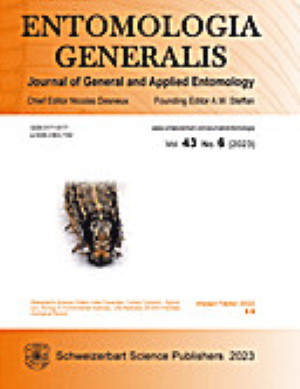Spinetoram exposure disrupts survival of flower bugs and leads to population collapse in orchards
IF 4.6
1区 农林科学
Q1 ENTOMOLOGY
引用次数: 0
Abstract
The increasing use of reduced-risk insecticides in orchard management has raised concerns regarding their potential risk to beneficial arthropods. Depending solely on acute short-term effects tends to underestimate the risks posed by spinetoram to natural enemies. Limited information is available on the long-term consequences of low exposure to spinetoram on natural enemies. The survival and predation of Orius strigicollis gradually decreased with the increase in spinetoram exposure rate, and the preoviposition periods were prolonged above 0.208 g a.i. ha-1. However, the adult lifespan, reproductive rate, population parameters, intrinsic rate of increase, finite rate of increase, and net reproductive rate were reduced, while the transformation rate was increased with the increase in spinetoram exposure rate. The population size and predation potential of O. strigicollis at 0.104 g a.i. ha-1 were higher than other treatments but did not differ from those of the control. Field residue monitoring showed that the peak residue levels of spinetoram on Eriobotrya japonica and Bidens alba flowers were 0.525–0.589 g ha-1 and 0.139–0.148 g ha-1, respectively, and it required at least 28 and 9 days, respectively, for the residue levels to dissipate to a level with no toxic effect on O. strigicollis. Therefore, the sublethal effects resulting from trace residues is the primary factor responsible for O. strigicollis population collapse. We provide insights for mitigating the negative impacts of spinetoram on O. strigicollis and for integrated pest management development.暴露于辛喷罗姆会破坏花虫的生存,导致果园中的花虫数量崩溃
果园管理中越来越多地使用低风险杀虫剂,这引起了人们对其对有益节肢动物潜在风险的关注。仅仅依靠急性短期影响往往会低估斯派诺林对天敌造成的风险。有关天敌长期接触斯派诺林的有限信息。随着斯皮内酯暴露量的增加,褐飞虱的存活率和捕食率逐渐下降,在 0.208 g a.i. ha-1 以上的暴露量下,褐飞虱的预伏期延长。然而,成虫寿命、繁殖率、种群参数、内在增长率、有限增长率和净生殖率均有所下降,而转化率则随着斯皮内酯暴露率的增加而上升。在 0.104 g a.i. ha-1 的条件下,O. strigicollis 的种群数量和捕食潜力高于其他处理,但与对照没有差异。田间残留监测表明,辛硫磷在枇杷和白花蛇舌草上的残留峰值分别为 0.525-0.589 g ha-1 和 0.139-0.148 g ha-1,分别至少需要 28 天和 9 天才能消散到对蛇舌草无毒性影响的水平。因此,痕量残留物造成的亚致死效应是导致稻飞虱种群崩溃的主要因素。我们的研究为减轻辛硫磷对稻田蛙的负面影响以及虫害综合防治的发展提供了启示。
本文章由计算机程序翻译,如有差异,请以英文原文为准。
求助全文
约1分钟内获得全文
求助全文
来源期刊

Entomologia Generalis
生物-昆虫学
CiteScore
7.10
自引率
18.80%
发文量
72
审稿时长
>12 weeks
期刊介绍:
Its scope covers all aspects of basic and applied research dealing with insects and more broadly with arthropods inhabiting wild, agricultural and/or urban habitats. The journal also considers research integrating various disciplines and issues within the broad field of entomology and ecology.
Entomologia Generalis publishes high quality research articles on advances in knowledge on the ecology and biology of arthropods, as well as on their importance for key ecosystems services, e.g. as biological control and pollination. The journal devotes special attention to contributions providing significant advances (i) on the fundamental knowledge and on sustainable control strategies of arthropod pests (including of stored products) and vectors of diseases, (ii) on the biology and ecology of beneficial arthropods, (iii) on the spread and impact of invasive pests, and (iv) on potential side effects of pest management methods.
Entomologia Generalis welcomes review articles on significant developments in the field of entomology. These are usually invited by the editorial board, but proposals may be sent to the Editor-in-Chief for preliminary assessment by the editorial board before formal submission to the journal. The journal also considers comments on papers published in Entomologia Generalis, as well as short notes on topics that are of broader interest.
 求助内容:
求助内容: 应助结果提醒方式:
应助结果提醒方式:


